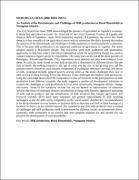| dc.description.abstract | MUHUMUZA OWEN (2008-M092-20073)
An Analysis of the Determinants and Challenges of Milk production in Rural Households in Ntungamo District.
The CIA World Fact book 2008 acknowledged the primacy of agriculture in Uganda‟s economy. It noted that agriculture accounts for 31percent of the Gross Domestic Product of Uganda and employs 80% of Ugandans. Apart from employing majority of Ugandans, the sector also feeds them. It is that centrality of the agricultural sector with its subsectors like dairy farming that makes the analysis of the determinants and challenges of milk production in rural households worthwhile. This is because milk production is an important subsector of agriculture in Uganda. The study adopted mainly a descriptive design. The researcher used both qualitative and quantitative approaches to help him collect theoretical explanations while the quantitative design was used to capture numerical figures given by respondents. The study was carried out in the three parishes of Rutunguru, Kitondo and Butanda. Fifty respondents were selected and data were collected from them. As such, the study found out that milk production is determined by different factors like the type of breed, the milking frequency, the age of cattle and the size of the grazing area and the pastures therein. However, most farmers complained of inadequate veterinary services, low prices of milk, prolonged drought, general poverty among others as the major challenges they face in their activity of dairy farming. Given the diversity of the challenges that bedevil milk production, using the knowledge drawn from the comparative review of literature on the good practices in milk production from different countries, the study suggests a number of development initiatives to counter the challenges to milk production in rural areas specifically, Ntungamo district, Ihunga sub-county. Some of the initiatives include but are not limited to improvement of extension services like those of veterinary doctors; introduction of cheap milk freezers; aggressive marketing of milk and its products and the subsidisation of milk investors like Sameer agriculture and livestock Limited, JESA farm dairy industries and general improvement of milk handling techniques so that the milk can be competitive on the world market. Another key recommendation is for the government to train farmers in business skills so that they can look at dairy farming as a business so that it can be commercialised. The conclusion was that milk producers face a myriad of challenges and milk production itself is determined by different factors as summarised above. Generally, milk production is an activity that once properly planned for and carried out can promote the development of rural households.
Key Words: Milk production, Rural Households, Ntungamo District. | en_US |


